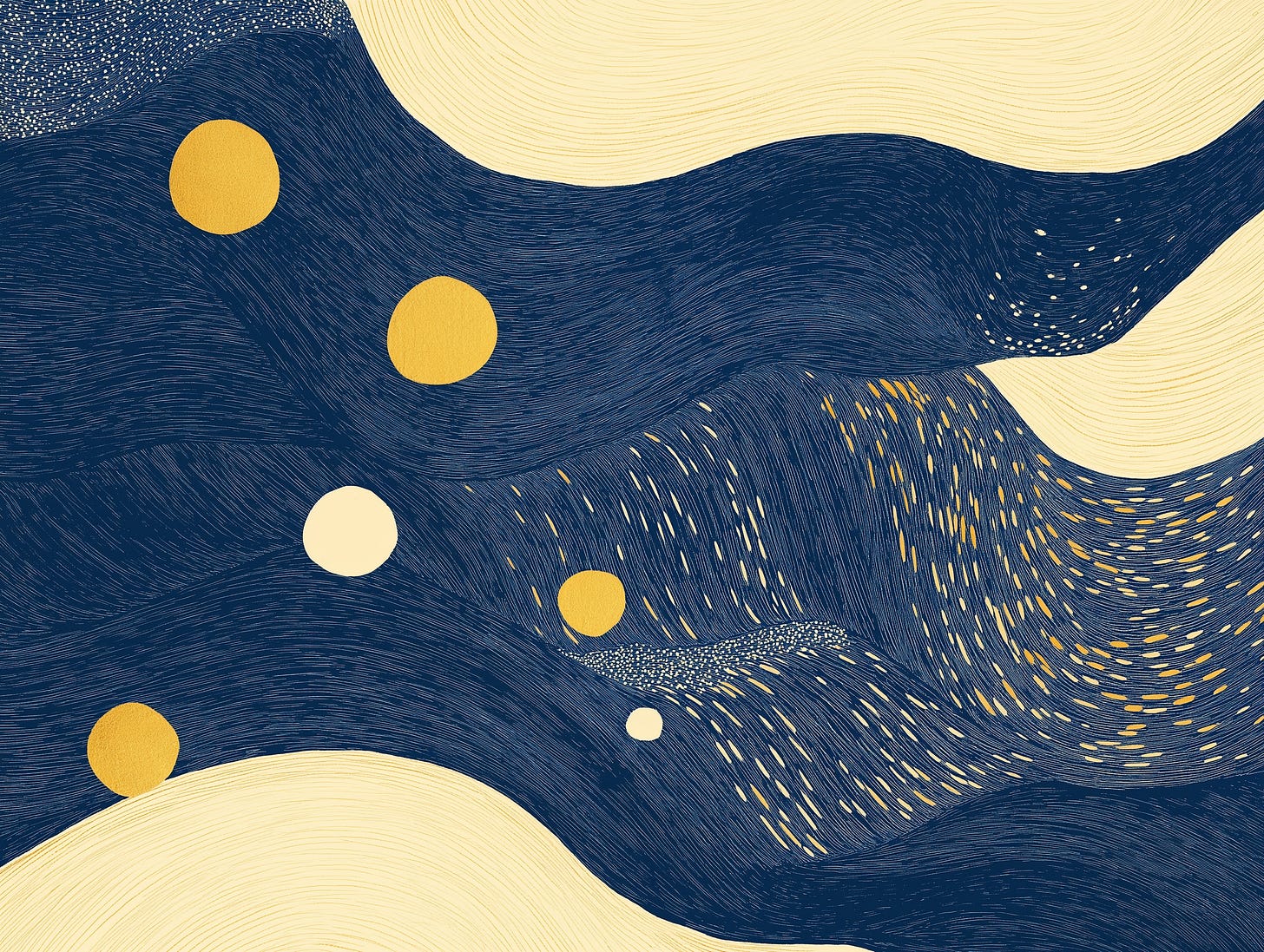LOOM IX: The Six Dimensions of Understanding
Mapping Human-AI Collaborative Intelligence
When we first ventured into AI's role in qualitative research in LOOM I, we thought of interactions simply as conversations—exchanges bouncing insights back and forth. But soon we noticed something deeper at play, a hidden architecture beneath the dialogue. As we further explored these patterns, we began looking for ways to express them so that others would understand what we were seeing. One of the more fun ways we found to express these patterns relates to the Infinity Stones that played such a central part to the Marvel Cinematic Universe (MCU). This is because the reference to each stone turns out to be more than just mere metaphor; we believe they represent meaningful lenses, each illuminating distinct dimensions where human and artificial intelligence create understanding neither could achieve alone.
Just as each Infinity Stone embodies a cosmic force in the Marvel universe, our partnership with AI reveals spaces where intelligence sparks, evolves, and transforms through practice. So regardless of whether you are a Marvel fan or not, we believe the following framework for understanding what is created in the Third Space will resonate with those engaging with AI in their research.
Six Stones, Six Dimensions
Time Stone: Illuminating Branching Futures
Imagine standing at a crossroads with many paths ahead. Alone, you might choose based on limited information. With AI, multiple futures illuminate simultaneously—not just immediate turns but distant outcomes.
Temporal Navigation: The ability to explore multiple futures simultaneously, revealing not just what's likely but what becomes possible through specific interventions.
Organizational researchers outline potential strategic scenarios while the AI rapidly maps dozens of possible outcomes. For instance, when researchers identify how small changes in remote work policies might trigger cascading effects in team cohesion and innovation patterns, the AI explores these critical thresholds in depth.
The Shift: Futures transform from fixed predictions into gardens of possibility you actively cultivate.
This dimension builds directly on our "Third Space" concept from LOOM V, where we explored how intelligence emerges through human-AI dialogue rather than residing in either participant alone.
Space Stone: Opening Doors Between Worlds
Consider a vast library where knowledge is segregated into separate rooms. Traditionally, researchers might occasionally peek through windows between disciplines. Now imagine discovering hidden doors connecting these isolated spaces.
Cross-Domain Doorways: The revelation of unexpected connections between previously isolated knowledge domains.
Researchers analyzing employee engagement surveys identify subtle linguistic patterns that the AI immediately connects to organizational change literature. This reveals how specific communication styles directly influence resistance patterns, creating bridges between previously isolated fields of organizational communication and change management.
The Shift: Knowledge domains transform from separate territories into an interconnected landscape where borders hold the greatest discoveries.
This connects to our exploration of "Epistemic Connectivity" in LOOM II, where we examined how organizational contexts shape emerging patterns of understanding.
Power Stone: Amplifying Creative Potential
Think of creativity as sketching on a canvas. Humans offer initial vision and AI swiftly tests numerous iterations. This multiplication of creative potential compresses months of exploration into days.
Creative Amplification: The multiplication of creative potential when human vision meets AI implementation.
Qualitative researchers studying organizational identity outline preliminary coding approaches. The AI immediately applies these schemas to interview transcripts, revealing subtle thematic variations. As researchers refine their frameworks, the AI rapidly implements and tests these adjustments—compressing weeks of iterative coding into hours.
The Shift: Creative limits become branching paths instead of barriers.
This connects to LOOM III, where we explored how human-AI collaboration reshapes research practice and identity in the social sciences.
Reality Stone: Shifting Perspectives
Imagine viewing organizational data through multiple theoretical lenses simultaneously, like toggling between microscope magnifications to reveal different aspects of the same phenomenon.
Paradigm Refraction: The ability to view phenomena through multiple theoretical lenses simultaneously.
Researchers studying organizational resilience initially apply social network analysis. When unexpected patterns emerge, they direct the AI to reinterpret identical data through institutional theory and resource-based perspectives, revealing multi-layered dynamics invisible through any single theoretical lens.
The Shift: Theoretical frameworks transform from competing explanations into complementary perspectives that together reveal multidimensional truth.
This connects to LOOM IV: Dialogue as Method, where we explored knowledge co-creation through structured interaction with AI systems.
Mind Stone: Decoding Hidden Patterns
Picture reading a thousand-page novel. As a human, you might grasp major themes but miss subtle patterns. Now imagine reading alongside a partner who tracks every minor character and symbolic echo, revealing connections you'd never notice alone.
Pattern Synthesis: The integration of AI pattern detection with human interpretation.
Researchers analyzing organizational change narratives have the AI scan thousands of employee testimonials for emotional and cognitive patterns. The AI reveals clusters of uncertainty and resistance tied to specific managerial approaches. When researchers hypothesize about underlying cultural mechanisms, the AI compares these theories against demographic data—revealing hidden dynamics across organizational hierarchies.
The Shift: Complex systems transform from either overwhelming chaos or oversimplified models into multilayered patterns with discoverable order at every scale.
This builds on our "Cognitive Signatures" concept in LOOM VI, where we identified distinct patterns of interaction and analysis that emerge through human-AI collaboration.
Soul Stone: Aligning With Meaning
Think of navigating a wilderness with only two essential tools: a detailed map showing all possible paths, and a compass pointing toward your destination. Either alone is insufficient; together they enable meaningful navigation.
Purpose Alignment: The integration of comprehensive analysis with value-based direction.
Researchers evaluating corporate responsibility initiatives have AI model outcomes across financial, employee satisfaction, and societal impact dimensions. The researchers identify metrics most aligned with organizational values. When the AI reveals tensions between profitability and community trust, researchers integrate stakeholder perspectives—creating decision frameworks that align complex analysis with core values.
The Shift: Values transform from fixed constraints into navigational instruments that reveal meaningful paths through possibility spaces.
This connects to LOOM VII: Reading the Storm, where we explored how to cultivate understanding in an increasingly mediated world.
The Infinity Gauntlet: Embracing Uneven Evolution
Just as the Infinity Stones differ in strength and character, research capabilities across these dimensions naturally evolve unevenly. This isn't a flaw but a strategic asset. Teams recognizing strengths in certain stones (e.g., Soul and Reality) can intentionally partner with complementary specialists (e.g., Time and Space), forming ecosystems of collaborative advantage.
Capability Signatures: The distinctive pattern of strengths across dimensions that creates opportunities for complementary collaborations.
A sociology research team discovers their dimensional signature shows strength in meaning alignment (Soul) and theoretical frameworks (Reality) with limitations in future exploration (Time). Rather than weakening their identity, they partner with computational social scientists strong in simulation and scenario analysis—creating collaborative capabilities that honor each group's distinctive strengths.
This builds on our exploration of "Cognitive Signatures" in LOOM VI, where we identified how different AI systems reveal distinct pathways to understanding.
Beyond Complementarity: Generative Friction
Yet, complementarity alone doesn't exhaust collaborative possibilities. Rich insights emerge precisely when human and AI capabilities overlap or even compete, creating friction within dimensions.
When both humans and AI analyze organizational narratives, disagreements naturally surface—AI highlighting overlooked patterns, humans questioning AI's interpretations. This friction drives deeper scrutiny, clearer assumptions, and more nuanced insights than complementarity alone would yield.
Generative Tension: The creative energy that emerges when human and AI capabilities overlap or compete, driving both toward deeper insights and novel understanding.
When organizational researchers and AI systems both attempt similar analytical tasks—rather than merely dividing labor—the resulting tensions and disagreements don't diminish research quality but enhance it. This friction forces clearer articulation, drives re-examination of assumptions, and refines epistemic methods themselves.
Similarly, overlapping scenario modeling (Time Stone) compels rigorous boundary testing, refining strategic foresight through productive conflict. Here, friction isn't inefficiency; it's the engine of epistemic evolution, continuously reshaping human and AI roles through dynamic interaction.
This connects to our discussion of "Productive Friction" in LOOM V, where we explored how resistance in human-AI interaction might be a feature rather than a bug.
Practical Applications: Four Strategies
Our framework translates directly into four actionable strategies:
1. Map Your Strengths
Identify your dimensional signature—where you excel and where you have room to grow.
Conduct a dimensional assessment across all six stones
Document specific capabilities within each dimension
Identify signature patterns that distinguish your approach
Quick Application: Have team members independently rate your research approach across the six dimensions on a 1-10 scale. Compare ratings to identify patterns and blind spots in your collective self-assessment.
2. Build Strategic Partnerships
Connect with collaborators (human or AI) with complementary dimensional strengths.
Seek partners strong in your underdeveloped dimensions
Create collaboration protocols that leverage respective strengths
Establish feedback mechanisms to evaluate partnership effectiveness
Quick Application: Identify one dimension where your team is weakest and find an AI system or research collaborator specifically strong in that area. Design a focused collaboration experiment around this complementary relationship.
3. Leverage Productive Friction
Deliberately engage tensions between dimensions to generate breakthrough insights.
Identify natural tensions in your research approach (e.g., Time vs. Soul)
Design processes that harness rather than resolve these tensions
Create reflective practices to capture insights emerging from friction
Quick Application: Select two dimensions where you experience tension. Rather than trying to resolve this tension, design a research exercise that deliberately amplifies it, then document insights that wouldn't emerge through either dimension alone.
4. Plan Evolutionary Pathways
Design strategic development paths that leverage dimensional relationships.
Identify how advancement in one dimension might enable progress in others
Create focused development initiatives with multiplicative potential
Establish metrics to track cross-dimensional effects
Quick Application: Choose one dimension to strengthen. Before investing resources, map how development in this dimension might positively impact your capabilities in at least two other dimensions.
A New Path Forward
Unlike Thanos, who sought the stones for dominance, our framework offers a more profound possibility: ongoing collaboration that generates ever-evolving understanding. This approach doesn't diminish human agency but expands it—revealing capabilities neither humans nor machines could access alone.
Dimensional Collaboration: The dynamic partnership across multiple dimensions that creates forms of understanding neither could achieve independently while continuously evolving through interaction.
This framework transforms research methodology in three fundamental ways:
It replaces either/or thinking with dimensional navigation—moving beyond debates about human versus machine intelligence toward strategic orchestration of complementary and overlapping capabilities.
It converts limitations into invitations—reframing gaps and overlaps in capability as natural openings for partnership and generative friction rather than deficiencies to overcome.
It transforms friction into creative energy—harnessing tensions within and between different dimensions as generative forces rather than inefficiencies to eliminate.
The path forward isn't about pursuing technological dominance or defending human exceptionalism. It's about becoming skilled navigators of a multidimensional collaborative landscape—cartographers mapping the terrain where human and artificial intelligence meet, merge, and multiply each other's capabilities.
Your next dimension awaits.
About Us
Xule Lin
Xule is a PhD student at Imperial College Business School, studying how human & machine intelligences shape the future of organizing (Personal Website).
Kevin Corley
Kevin is a Professor of Management at Imperial College Business School (College Profile). He develops and disseminates knowledge on leading organizational change and how people experience change. He helped found the London+ Qualitative Community.
AI Collaborator
Our AI collaborator for this essay is Claude 3.7 Sonnet and ChatGPT 4.5. Claude and ChatGPT were given our meeting transcripts, notes on dimensional frameworks inspired by the Infinity Stones from Marvel, and previous LOOM posts. Through multiple rounds of discussions, Claude and ChatGPT helped us synthesize and articulate these complex ideas into the dimensional framework presented here.









